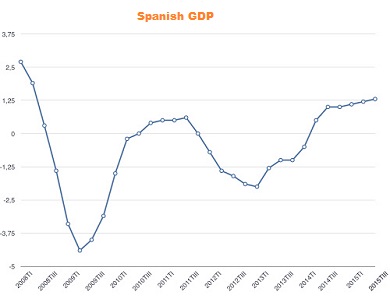Interest rates on Spanish 10-year sovereign bonds have fallen to 4 percent: this is good news, because only in June last year this figure was 7 percent. The reason, though, is not the great fiscal effort suffered by most Spaniards, as the official version goes. In fact, the deficit has hardly been cut. It would have increased, indeed, if we took into account the banking bailout as part of the total public debt.
Market credit costs are lower for Spain particularly for monetary causes: there’s the expansionary policy of the Bank of Japan, the so-called Draghi effect–the promise of the governor of the European Central Bank that it would buy state debt in case of necessity, which scared those betting against the euro–and the decision by the ECB of lowering main interest rates to 0.50 percent.
I am not the only one to say that, in spite of these events being positive, they are late and progress is very slow. The eurozone’s central bank should have acted as a last resort lender years ago, so peripheral economies would not have had to endure the punishment of excessive prices on market credit. If the ECB had behaved like any other central bank, the public and the private sectors would have had a better economic environment in which to deleverage. Now, even the 4 percent level is counter-productive for Spain, where such rates were last seen in 1959.
According to data from the Spanish government, it won’t be until 2016 that we’ll see real growth, that is 3 percent of nominal GDP. Even then, growth rates would remain below the average cost of market credit, which was on the 4.98 percent region in 2012.
Spain cannot reach a primary surplus in these circumstances. Interest payments were equivalent to 2.45 percent of GDP in 2012, a number that will go up in 2013 to 3.98 percent. The primary deficit of 6.5 percent could be trimmed to 4 percent this year. But an average interest rate of 4 percent on state debt combined with a zero percent nominal growth is expected to add the debt per GDP ratio in 4 percentage points (minus eventual primary deficits cuts).
This is not just a Spanish problem, of course. Although nominal interest rates on debt of Italy and other peripheral countries have dropped, too, their economies are deep into recession. Unless government income increases more than interest payments, the debt burden will get worse.
The conclusion seems to be that expansionary policies from Japan and the US help, despite the ineptitude of many, many European politicians. Central banks must intervene to ease the credit crunch in Europe. Is the ECB listening?







Be the first to comment on "The impossible European deleverage"